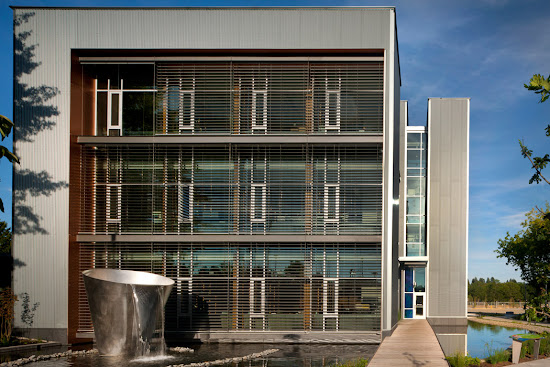 |
The Miller Hull Partnership designed a LEED Platinum-certified four-story office and education building (2009) for the LOTT Clean Water Alliance in Olympia, Washington. Photo: Nic Lehoux |
HOK, The Miller Hull Partnership, High Plains Architects, HMC Architects, and Serena Sturm Architects are highlighted in the 30-page document, which was prepared by Megan Turner, the 2012 AIA/COTE COTE Research Scholar.
Download the case study PDF at:
http://www.aia.org/aiaucmp/groups/aia/documents/pdf/aiab096492.pdf
 |
| The AIA's plan for a deep energy retrofit of its headquarters building (1973), in Washington, D.C., originally scheduled for completion in 2012, has reportedly been delayed because of funding issues. Photo: Kevin Matthews/ Artifice Images |
"In order to examine the benefits and lessons learned from firms participating in the American Institute of Architects (AIA) 2030 Commitment Program, five participating firms were interviewed and case studies documenting their experiences were developed. The program began in 2009 and is a voluntary initiative for AIA member firms and other entities in the built environment that asks these organizations to make a pledge, develop multi-year action plans, and implement steps that can advance AIA’s goal of carbon neutral buildings by the year 2030.
"The purpose of the case studies was to delve into business factors, behavioral science, and organizational change, to explore how firms can successfully adopt the AIA 2030 Commitment to steer their building portfolios toward lower carbon solutions. The case studies identified patterns that enhance successful implementation, obstacles and challenges encountered by firms through the stages of implementation, and illuminated the unique ways in which firms have addressed and overcome them.
"The key findings were that the firms have gained greater insight to the energy performance of their design projects, have improved their process for reporting metrics and are now armed with better real-world success examples to share with clients highlighting the economic value of sustainable design.
"Participating firms included High Plains Architects, HMC Architects, HOK, The Miller Hull Partnership and Serena Sturm Architects. Together the firms achieved an average predicted energy use intensity of 49.5% placing them ahead of overall performance reported by participating firms in 2012, but below the target goals of the program."
See also: AIA Energy Modeling Practice Guide
No comments:
Post a Comment